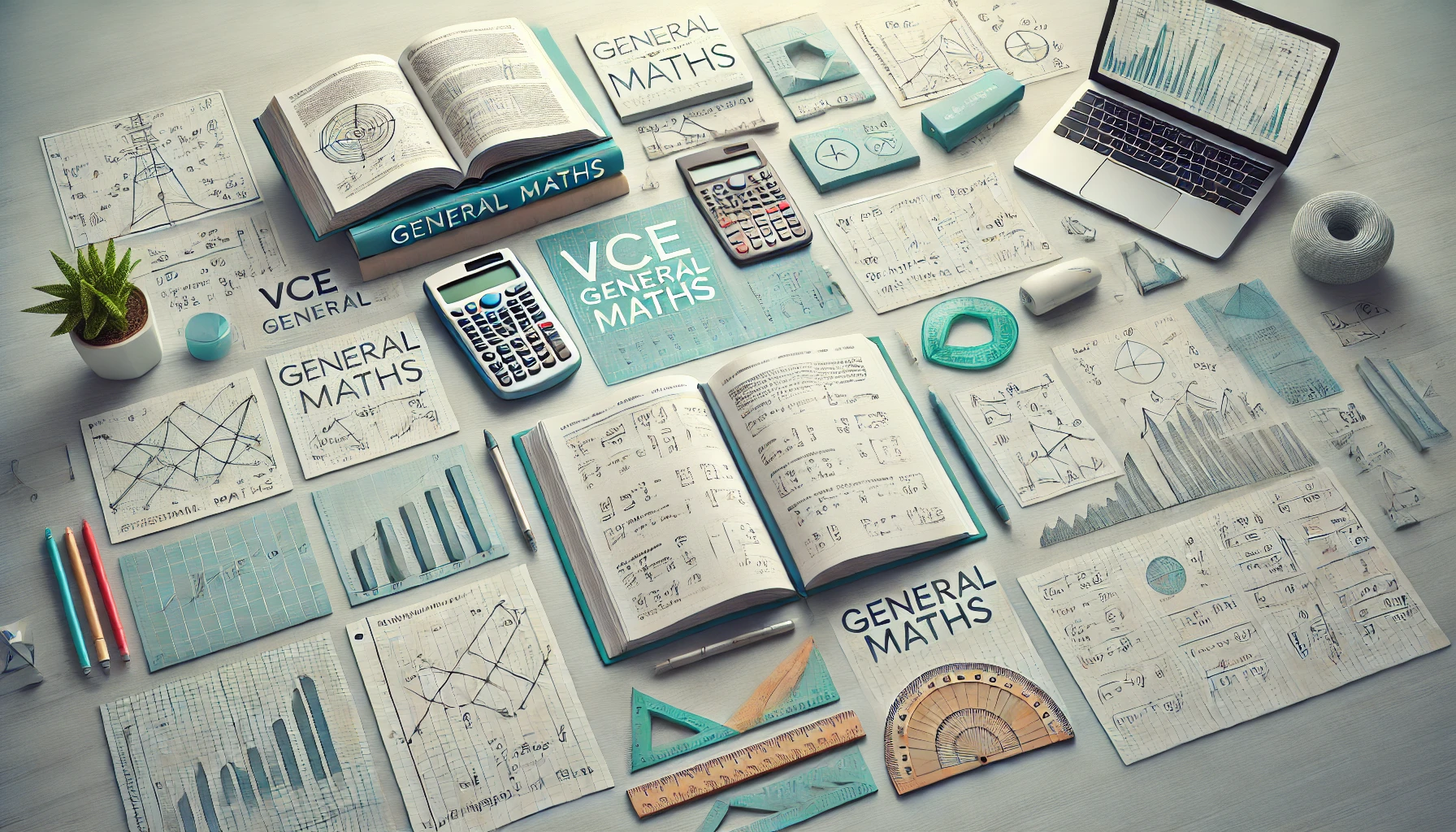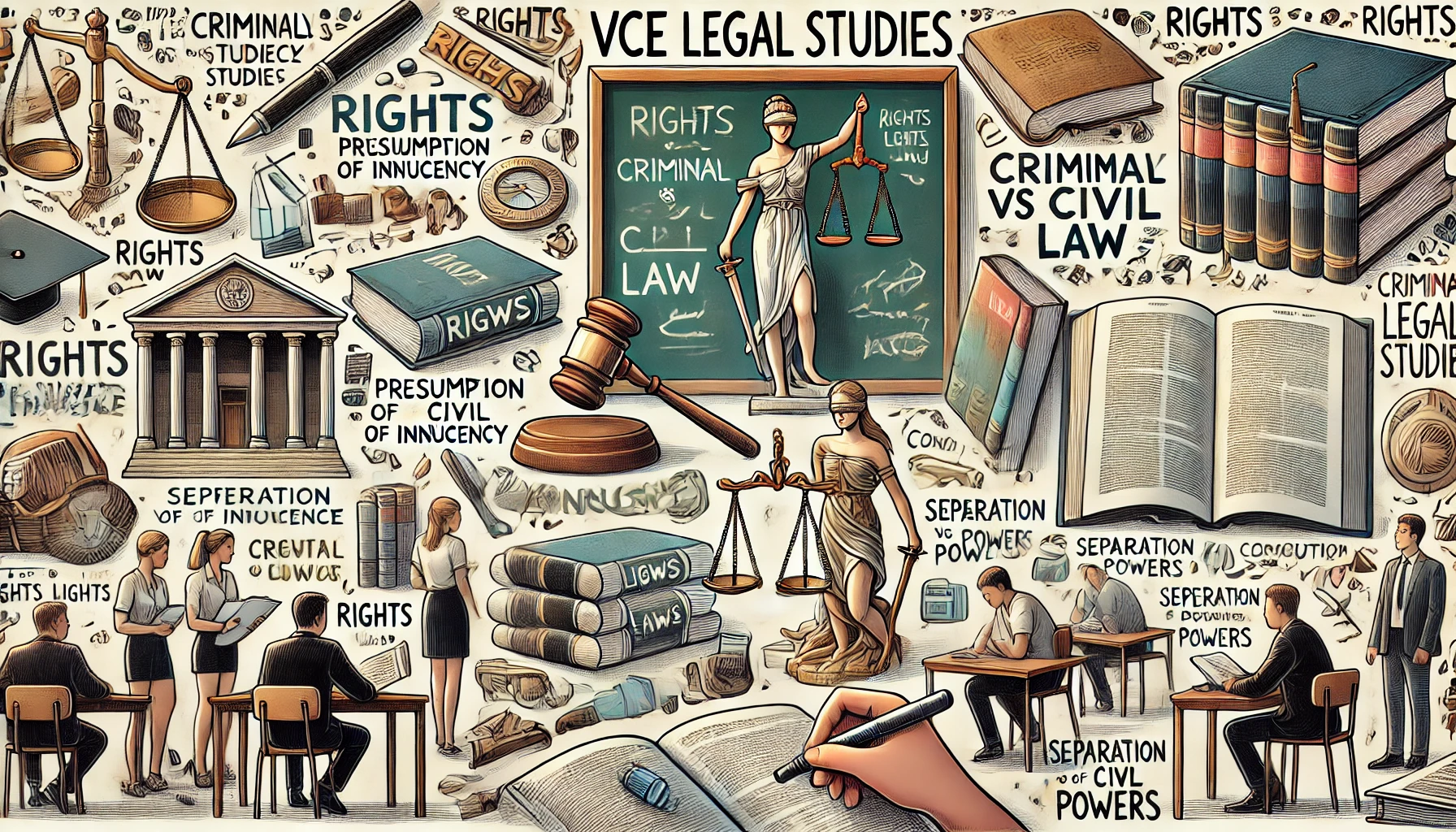
VCE General Mathematics is one of the most accessible and practical senior maths subjects offered in the Victorian Certificate of Education (VCE). Designed to equip students with essential problem-solving and analytical skills, it covers real-world applications in finance, data analysis, networks, matrices, and measurement.
What topics are covered in VCE General Maths?
VCE General Mathematics Units 1–4 cover a broad range of non-calculus and discrete mathematics topics designed to reflect real-world contexts. These topics are organised into four main Areas of Study. While the exact combination may vary across Units 1–4, the following areas provide a consistent structure throughout the subject:
1. Data Analysis, Probability and Statistics
Students explore data collection, representation, and interpretation. Key concepts include:
- Investigating and comparing data distributions using graphs (e.g., boxplots, histograms).
- Summary statistics such as mean, median, interquartile range (IQR), and standard deviation.
- Relationships between two numerical variables using scatterplots and lines of best fit.
- Interpretation of association and causation in real-world data.
2. Algebra, Number and Structure
This area introduces sequences, financial mathematics, and recurrence relations. Students will:
- Work with arithmetic and geometric sequences.
- Use first-order linear recurrence relations to model simple interest, loans, and depreciation.
- Apply percentage changes, mark-ups, discounts, and unitary methods in financial contexts.
3. Functions, Relations and Graphs
Students examine linear relationships and their applications. Key content includes:
- Graphing and interpreting linear functions and equations.
- Modelling real-life scenarios using linear and piecewise-linear graphs (e.g., tax scales).
- Solving linear and simultaneous equations and interpreting their solutions.
4. Discrete Mathematics
This area focuses on matrices and networks to model practical problems. Students will learn:
- Matrix operations including addition, multiplication, and inverses.
- Using matrices to model systems such as transport or communication networks.
- Transition matrices and modelling population changes or long-term trends.
- Graph theory and networks including paths, circuits, and shortest paths (Unit 2).
5. Space and Measurement (Unit 2 only)
In Unit 2, students study measurement, similarity, trigonometry, and navigation. This includes:
- Applying trigonometric ratios and Pythagoras’ theorem.
- Using the sine and cosine rules in non-right-angled triangles.
- Calculating surface areas, volumes, and applying scale factors in practical contexts.
💡 Check out how you can improve your General Maths Score here!

Why study VCE General Maths?
VCE General Mathematics offers a practical and accessible pathway for students who want to develop essential numeracy and problem-solving skills without the focus on calculus seen in other maths subjects. It’s particularly suited for students planning to pursue further education in fields such as business, commerce, the social sciences, health sciences, trades, or apprenticeships, where mathematical literacy is valuable but advanced calculus is not required.
Many Australian universities recognise VCE General Maths as a suitable prerequisite or recommended subject for entry into a wide range of tertiary courses. For example, degrees in education, nursing, psychology, and business often list General Maths as sufficient for meeting assumed knowledge requirements in mathematics. Even for courses that don’t require maths, having completed General Maths can strengthen your ATAR and demonstrate your readiness for numerically demanding coursework.
Are there any prerequisites for VCE General Maths?
There are no formal prerequisites for enrolling in VCE General Mathematics Units 1, 2, or 3. This means students can enter the subject without having completed any specific Year 10 or earlier mathematics units. However, it is recommended that students undertaking General Maths in Units 3 and 4 have completed General Maths Units 1 and 2 or equivalent studies, as these provide the assumed knowledge and foundational skills required for success in the Year 12 curriculum.
Unlike Mathematical Methods or Specialist Mathematics, General Maths does not assume prior knowledge of calculus or advanced algebra. This makes it a popular choice for students looking for a balanced and real-world-oriented maths subject that supports a range of post-school pathways, including university, TAFE, and direct entry into the workforce.
What skills or capabilities are required to do VCE General Maths?
VCE General Mathematics is designed to be accessible to a wide range of students, but success in the subject still requires a solid foundation in basic numeracy and a willingness to apply maths to real-world situations. Key capabilities include:
- Numerical reasoning – comfort with percentages, ratios, decimals, and arithmetic operations.
- Logical thinking – interpreting data, analysing problems, and applying step-by-step procedures.
- Familiarity with technology – using CAS calculators and digital tools to solve problems, interpret graphs, and perform matrix operations.
- Communication – clearly explaining mathematical reasoning in written form, especially for investigations and applied tasks.
While students don’t need to be “maths whizzes,” they do need to engage consistently with classwork and practise applying concepts to a range of practical contexts such as budgeting, networks, or interpreting data sets.
What type of students should do VCE General Maths?
General Maths is ideal for students who prefer practical and applied learning over abstract or theoretical mathematics. It suits those who are:
- Planning to pursue tertiary courses that don’t require calculus (e.g. nursing, psychology, business, education).
- Interested in real-world applications like financial modelling, data analysis, and networks.
- Seeking to boost their ATAR with a maths subject that supports a wide range of university or TAFE pathways.
- Looking for a balanced Year 12 workload, particularly if they’re already doing content-heavy or literacy-based subjects.
It’s a particularly good option for students who may have found Year 10 Maths challenging but still want to keep university options open by studying a VCE mathematics subject.

How is VCE General Maths assessed?
VCE General Mathematics assessment is designed to evaluate both students’ understanding of key concepts and their ability to apply mathematical techniques in practical and unfamiliar situations. The assessment structure is split between school-based assessment (SACs) and external exams, which together determine the final study score out of 50.
School-Based Assessment (Units 3 & 4)
There are two school-assessed coursework components, each focusing on different parts of the curriculum:
These SACs typically include:
- Application tasks: Extended tasks involving modelling or problem-solving using real-world data. These assess students’ ability to formulate problems, select appropriate mathematical techniques, use technology effectively (CAS calculator), and interpret results.
- Short-answer questions: Focused on mathematical routines and procedures from the Areas of Study (e.g. matrices, data analysis, sequences).
Tasks must assess all three outcomes:
- Applying key knowledge and mathematical routines.
- Modelling and problem-solving in unfamiliar or practical contexts.
- Using technology (such as CAS calculators) effectively to produce and interpret results.
External Assessment (Examinations)
At the end of Unit 4, students complete two external exams, each worth 30% of the total study score.
Exam 1 (Technology-Free)
- Focuses on short-answer questions.
- Tests students' ability to apply mathematical skills without the aid of technology.
- Examines understanding of definitions, formulas, graphs, and manual calculations.
Exam 2 (Technology-Assisted)
- Includes short-answer and extended response questions.
- Requires the use of CAS calculators to perform complex computations, graphing, solving equations, and interpreting output.
- Tasks often involve real-world applications, requiring students to explain reasoning, justify answers, and interpret results in context.
What are examiners looking for?
Examiners assess:
- Mathematical accuracy: Correct application of procedures, clear working out, and accurate results.
- Understanding: Demonstration of conceptual understanding, not just memorised steps.
- Reasoning and interpretation: Ability to explain, justify, or interpret answers, especially in modelling or data-related tasks.
- Use of technology: Appropriate and effective use of CAS calculators in Exam 2.
Students are rewarded not just for the final answer, but for their method, clarity of reasoning, and interpretation in context—especially in complex or unfamiliar problems.
💡Find out how one of our tutors achieved a raw 50 in General Maths!
Tips to succeed in VCE General Maths
Success in VCE General Mathematics relies on consistent effort, strategic preparation, and knowing how to leverage the subject’s strengths. Here are specific, actionable tips for students:
1. Master your CAS calculator early
The CAS calculator (e.g. TI-Nspire or Casio ClassPad) is essential in Exam 2 and SACs. Learn how to:
- Perform matrix operations and solve systems of equations.
- Plot and analyse graphs efficiently.
- Use financial maths functions for compound interest, depreciation, and annuities.
- Practising with your calculator under timed conditions is key to speed and accuracy.
2. Prioritise real-world application questions
Application and modelling tasks make up a significant portion of SACs and often appear in exams. To prepare:
- Practise setting up equations or recurrence relations from worded problems (e.g. loan repayment scenarios or network optimisation).
- Focus on interpreting your solutions in context — marks are awarded for explanation and justification, not just numerical answers.
3. Know the common traps in Exam 1
Exam 1 is technology-free and tests core skills. Avoid losing marks by:
- Being fluent with by-hand algebra and percentage calculations.
- Memorising key formulas (e.g. for mean, IQR, surface area).
- Practising questions where you need to sketch graphs or manipulate equations without CAS support.
4. Don’t ignore Discrete Maths
Topics like matrices and networks are often unfamiliar to students — but they are highly examinable and often straightforward once understood. Don’t neglect:
- Matrix multiplication and transition matrices.
- Concepts like shortest paths, Euler’s formula, and minimum spanning trees in network problems.
5. Refine your written communication
Many exam and SAC marks depend on how well you explain your reasoning, especially in data analysis or financial questions. Practise:
- Justifying trends from scatterplots or boxplots.
- Interpreting the slope and intercept of a linear model in context.
- Writing clear, concise explanations in full sentences.
6. Use exam reports and past papers strategically
The VCAA exam reports explain where students commonly lose marks. Use these to:
- Spot patterns in examiner expectations.
- Understand how to present answers — especially for modelling tasks or when using CAS output.
- Focus revision on frequently assessed skills (e.g. constructing and interpreting piecewise graphs, working with percentage change).

What are the most common mistakes VCE General Maths students make?
1. Misusing or underusing the CAS calculator
Many students fail to use the full capabilities of their CAS calculator in Exam 2. Common issues include:
- Using manual steps for problems that could be quickly solved using built-in functions (e.g. solving recurrence relations or analysing graphs).
- Misreading calculator outputs or copying values incorrectly.
- Forgetting to use the correct settings or modes (e.g. degree vs. radian mode for trigonometry).
2. Not answering in context
Examiners regularly deduct marks when students give correct mathematical answers but fail to:
- Link the answer back to the question scenario.
- Include correct units (e.g. dollars, years, metres).
- State whether the solution is practical or realistic (especially in modelling tasks).
3. Weak understanding of newer or unfamiliar topics
Topics such as matrices, networks, and recurrence relations are unique to General Maths and often trip up students who:
- Memorise steps without understanding the logic behind them.
- Struggle to set up real-world problems using matrices or transitions.
- Forget the difference between arithmetic and geometric growth models.
4. Over-reliance on rote learning
General Maths heavily assesses application and interpretation. Students who rely purely on repetition or drilled textbook questions often:
- Struggle with unfamiliar or applied problems.
- Can’t adapt methods to solve open-ended tasks or mathematical investigations.
5. Neglecting Exam 1 preparation
Because Exam 2 is technology-assisted, many students spend less time preparing for Exam 1, which is technology-free. This results in:
- Careless errors in by-hand algebra or arithmetic.
- Poor performance in foundational skills like simplifying expressions, solving equations, or interpreting graphs manually.
Conclusion
VCE General Maths offers students a practical and rewarding pathway through senior mathematics, equipping them with essential skills for university, TAFE, or the workforce. With the right strategies, consistent practice, and strong support, students can excel in both school-based and exam assessments. If you’re looking for expert guidance, personalised support, or just a confidence boost in your studies, Apex Tuition Australia offers experienced VCE General Maths tutors ready to help you succeed.








